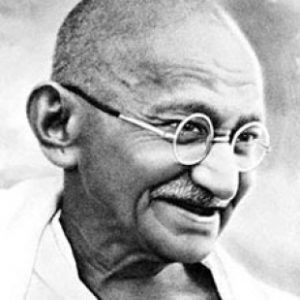Flames Consume Body of Ghandi As Fires of Violence Lick at India, The Atlanta Constitution, Feb. 1, 1948.
 Click here to view the original article. Click here for more on The Partition of India.
Click here to view the original article. Click here for more on The Partition of India.
NEW DELHI, India, Jan. 31-(UP)-The wizened body of saintly Mohandas K. Gandhi was cremated in the presence of hundreds of thousands abject mourners on the muddy banks of the sacred Jumna River at dusk Saturday while insane violence bloodied the streets of three Indian cities.
The earthly remains of the 78-year-old man of peace were consumed on a pyre of scented sandal wood while the sobbing, moaning multitudes intoned ancient Hindu prayers and shouted “Gandhi still lives!” “victory to Gandhi!”
At least 100 persons were injured in a stampede among the mourners when the torch was put to the pyre.
In an ironic postscript to Gandhi’s life of non-violence and self control, the frenzied mourners crashed through police and military lines toward the towering flames. Some were attempting to leap into the fire and join their revered leader in death. But a charge by police armed with metal tipped staves stemmed the rush.
But even as flames began to lick the body which was attired as in life, in the familiar, hand spun white cloth, reports of renewed rioting came from Bombay where the latest official figures placed the two-day death toll at 22 with at least 46 wounded. Savage communal rioting erupted in Poona City, 100 miles southeast of Bombay, and at Kolahpur. 300 miles farther south.
Large crowds wandered through Bombay’s streets attacking shops and offices of persons known to be members of Mahasabba, the extremist Hindu organization to which Gandhi’s assassin, Narayan Vinayak Cadse, belonged.
Police imposed a curfew to curb looting and arson. Casualties were comparatively light chiefly because police fired only when necessary to save their own lives.
In the suburbs of Dadar and Hamim, which are almost completely Hindu, mobs set fire to the homes of Mahasabha workers and prevented fire brigades from quenching the flames. The mobs also stance police. Shops were looted. Bonfires smouldered in the streets-the remains of loot too heavy or not valuable enough to carry away.
In one Bombay mill area, a truckload of Hindus stopped in the main road and began stoning buildings belonging to Mahasabnites. “It is almost impossible to stop looting.” a Bombay police inspector said, “because we can’t fire for fear of hitting little children who are everywhere.”
But Bombay police were forced to open fire on Girgaum Road to disperse mobs attacking a Mahasabnite office and similar situations were developing throughout the provincial capital.
Bombay police arrested 15 persons believed to belong to the group that plotted Gandhi’s assassination. Officials said it was thought the group conducted a “lottery” to decide which member would be the trigger man to still the Indian leader’s powerful voice.
Gandhi’s assassin was described by persons who know him as a “maniac.” He was editor of the militant extreme-anti-Congress Party newspaper Hindu Rashtra in Poona.
The assassin, a medium-built, sharp-featured Hindu, meanwhile sat, unconcerned, in New Delhi’s Parliament Street Jail where secret service investigators questioned him continuously, seeking the names of accomplices.
“All he says,” a police official told the United Press, “is I considered I should shoot him.”
A reliable source reported, however, that Gadse told police he was present in New Delhi at the Marina Hotel when a plot to bomb Gandhi miscarried Jan. 20. He reportedly said five associates fled when that assassination plot failed.
Rioting broke out in Poona, and first reports said two persons were injured and three buildings set afire. Troops were called out to quell infuriated mobs which were attacking alleged Mahasabhites.
A curfew was imposed on Poona’s western sector.



